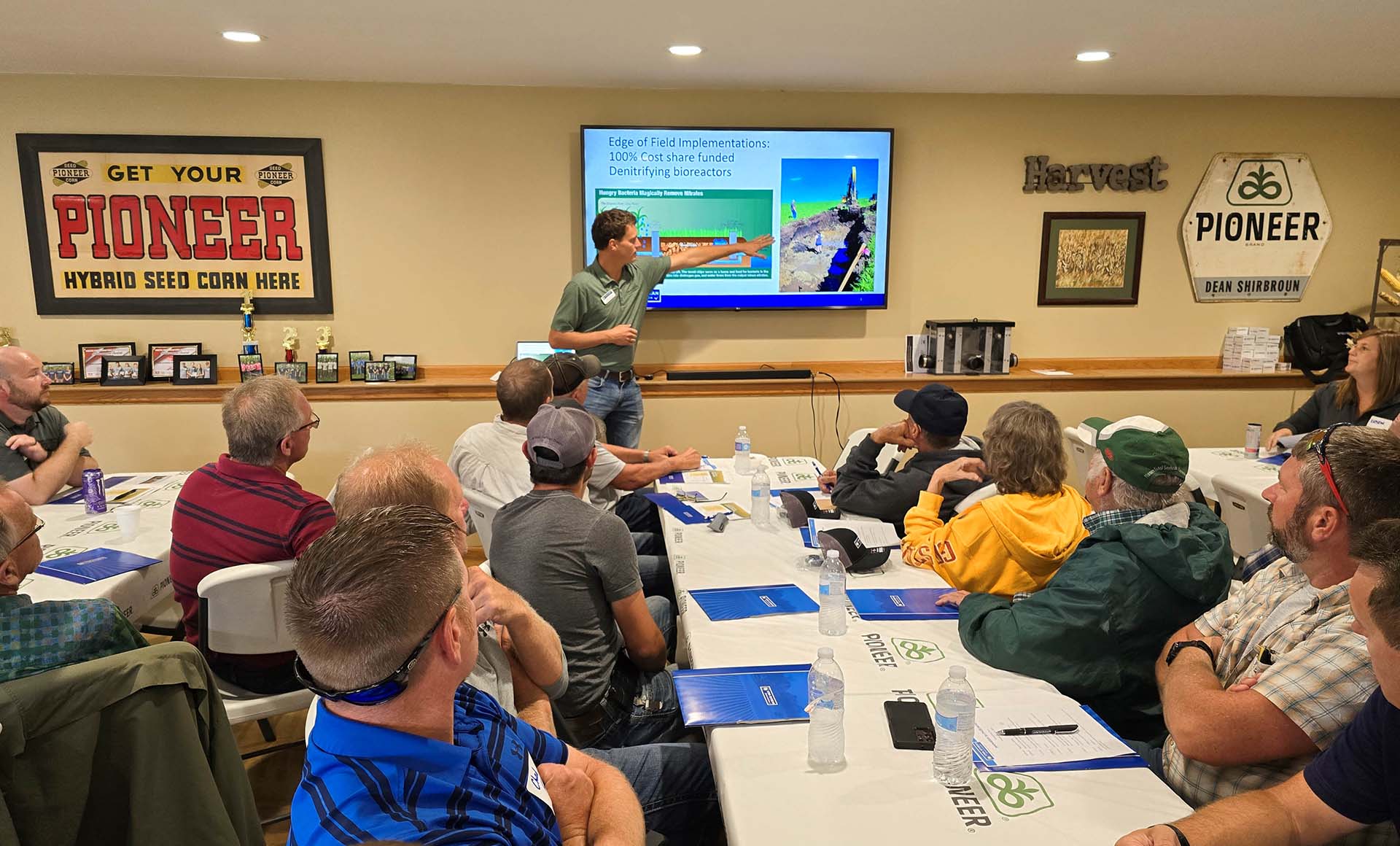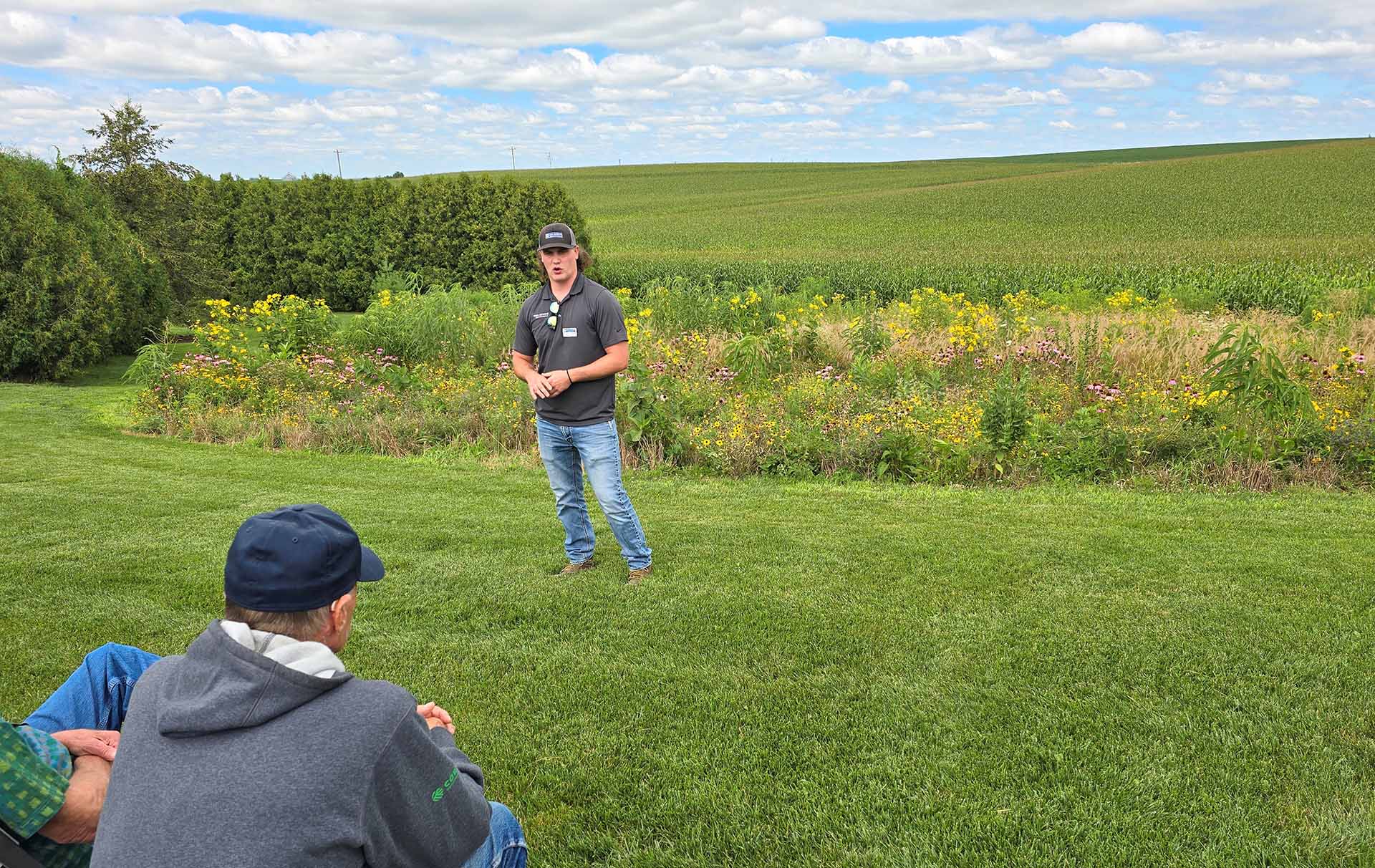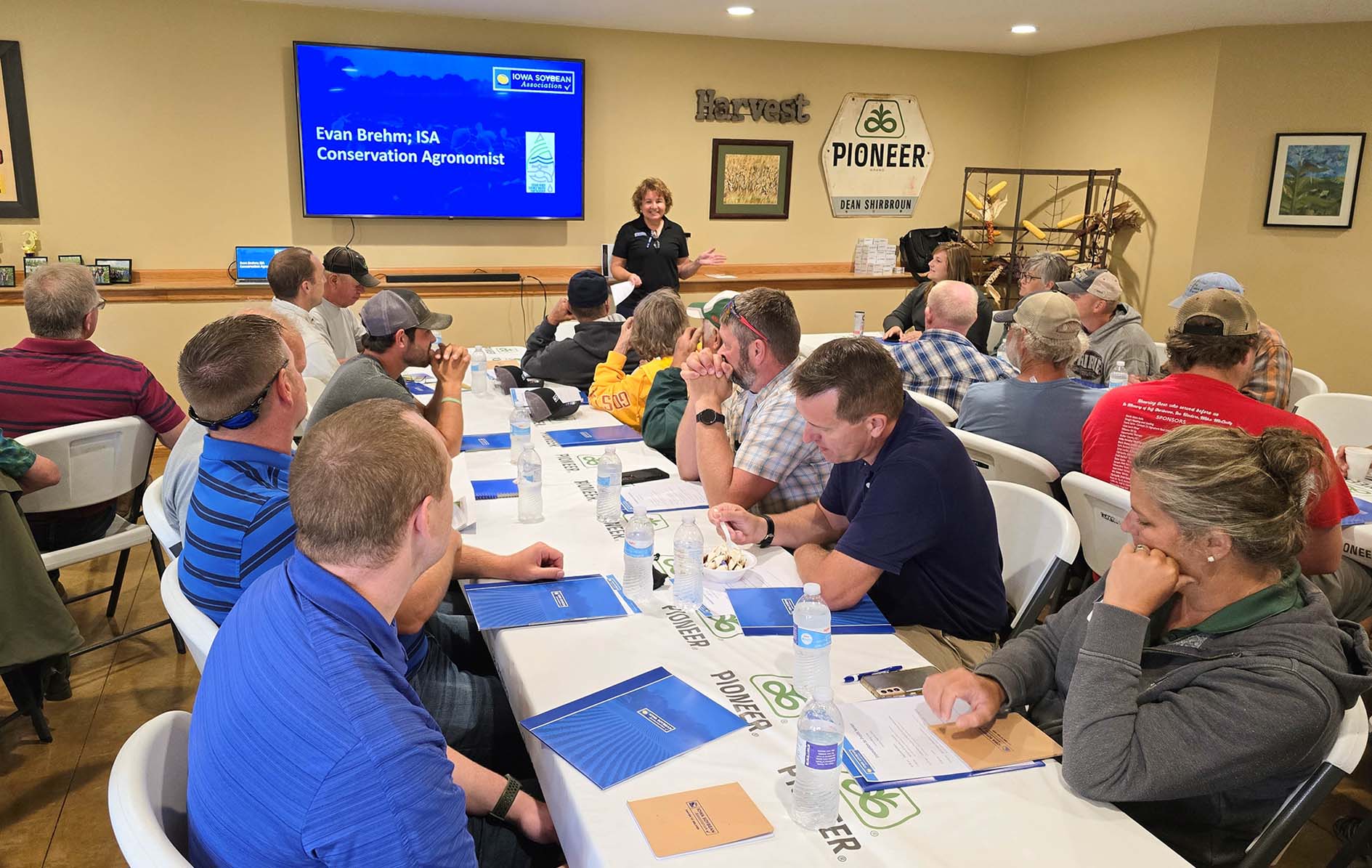
(Photo: Iowa Soybean Association / Jeff Hutton)
Conservation, incentives and habitat restoration showcased
August 15, 2024
From conservation practices, cost-share programs and finding ways to protect pollinator habitats, farmers got a sample of what Iowa Soybean Association (ISA) and others are doing to make a difference on the farm.
During the most recent ISA Innovation to Profit (I2P) event at the Joe and Suzanne Shirbroun farm outside of Farmersburg, participants heard about conservation programs and cost-share opportunities with Evan Brehm, ISA conservation agronomist. They were encouraged to explore various cost-share programs in the state geared toward cover crops and edge-of-field practices including a discussion on the agronomics of cover crops and why acres have increased to nearly 4 million acres in 2024. They also learned water monitoring on edge-of-field practices reduced nitrates between 25% and 90% in 2023.
There was also a Soil & Water Outcomes Fund (SWOF) discussion with Brogan Schanz, SWOF field program representative. Participants received an overview of SWOF and how farmers can sign their acres up for the program and how the organization quantifies environmental outcomes and works with partners to create payments for farmers based upon those outcomes.
And ISA Conservation Services Manager Brandon Iddings helped event attendees uncover the benefits of converting unproductive ground into native pollinator prairie, including what it takes to establish one’s own prairie and cost-share opportunities to help cover the costs.

Cover crops and other conservation practices
Brehm says many farmers across the state are starting to dip their toes into conservation, or in some cases, have dived right into practices that can be effective on their farms.
“There are many financial incentives and programs out there that can help,” he says.
Whether it’s bioreactors, edge-of-field practices, saturated buffers or cover crops, the benefits can be a boon to farmers and the overall environment.
“These practices can help reduce nitrates in our water sources,” he says. “It’s also allowing the freedom to farm and get ahead of any potential regulations that might come our way.”
Brehm says practices like saturated buffers and bioreactors can help slow down nitrate loss. Both practices can reduce nitrates on average about 45%, he says, adding he has seen results range from 25-70%.
He pointed to Batch and Build projects like the one in Linn County near Cedar Rapids, with cooperating farmers participating in the effort.
Batch and Build removes barriers to putting in bioreactors and saturated buffers at the edges of fields. Saturated buffers and bioreactors connect to tile lines at the edge of fields to remove nitrate before it enters local waterways.
Brehm also pointed to the importance of cover crops, noting the practice has grown significantly in recent years.
“In the state, we had less than 10,000 acres of cover crops about 12 years ago; now we’re at about 4 million acres,” he says.
And money is available for those farmers who haven’t begun a cover crop program or want to expand the practice.
Brehm says there are public funds from organizations like Farmers for Soil Health, the Iowa Department of Agriculture and Land Stewardship’s (IDALS) Water Quality Initiative, the Natural Resources Conservation Services’ (NRCS) Environmental Quality Incentives Program (EQIP) or the NRCS’ Conservation Services Program (CSP).
There is also private funding from entities like the Practical Farmers of Iowa and Truterra, as well as assistance from SWOF and the Regional Conservation Partnership Program.
“The goal of ISA is to help farmers stack these programs or simply get started,” Brehm says. “As conservation agronomists, this is what we do and we want to help you with this.”
Through cover crops, Brehm says some ISA farmer-members have seen the agronomic benefits from water quality to weed suppression,
“We hope you gain agronomic benefits and environmental benefits, but we also want to help you financially,” he says.
Implementing cover crops and finding success is not an overnight proposition, but Brehm says over the long-term, farmers and non-farmers are seeing the benefits, like lowering the costs and uses for herbicides and other inputs.
“And we can help with what works for your farm,” he says, whether it’s planting grasses like oats or cereal rye, legumes like hairy vetch or brassicas like radishes or winter camelina.
“Overall, we’re seeing that more farmers are becoming comfortable planting green,” Brehm says.

Bees and minnows
At the Shirbroun farm, Iddings highlighted a pollinator field close to crops that have been planted.
Wildflowers and other vegetation decorated the field, a place where habitat can thrive.
Iddings says the ISA, in cooperation with Syngenta and the U.S. Fish and Wildlife Service, is working with farmers and landowners to restore pollinator habitats that benefit endangered species like the rusty-patched bumble bee and other pollinators.
“Our goal is to show how voluntary conservation efforts are more successful than regulations,” he says.
The rusty-patch bumble bee needs a unique habitat, which is one reason for the push to create these pollinator habitats for those insects as well as other pollinators like Monarch butterflies.
Iddings says these types of restoration efforts provide habitat for bees and butterflies, and also help with soil erosion, nitrate loss and acts as natural buffer strips.
He says ISA typically helps to work on 2-10 acres or more with farmers who are seeking diverse, high-quality pollinator habitat.
ISA, Iddings says, works with the U.S. Department of Agriculture and others, to establish these opportunities with some cost-sharing and if possible, CRP augmentation – facilitating the use of CRP land to build these habitats.
There is also the work ISA is doing on oxbow restoration.
Iddings says oxbows, the U-shaped extension of a stream, river or creek that becomes separated from the main channel, can be restored to help with water quality and habitat improvements.
Like the rusty-patched bumble bee, the Topeka shiner minnow is also threatened.
Oxbow restoration can act as nurseries for the Topeka shiner and other water species who depend on these liquid resources.
Iddings says with help from the U.S. Fish and Wildlife Service, 200 oxbows have been restored in the state from 2001-20.
“Last year, we had 50 oxbow restorations and that’s helping downlist the Topeka shiner from endangered to threatened,” he says.
Iddings says ISA wants farmers and landowners to get the “biggest bang for your buck” through these conservation and habitat rehabilitation projects.
“We can help you figure out what to do on your farm, making sure it works and that it’s voluntary,” he says.
SWOF efforts
During the I2P event, members of the Soil and Water Outcomes Fund shared insights on how SWOF provides financial incentives directly to farmers who implement new conservation practices that yield environmental outcomes like carbon sequestration and water quality improvements.
SWOF Field Program Representative from Eastern Iowa Brogan Schanz shared how on average participating farmers received $33 per acre payment in 2023 with no limits on the number of acres enrolled.
SWOF Business Development Contractor Steve May says the program is one of the easiest programs to enroll in and brings together everyone along the supply chain – farmer to corporation.
“When these companies (many Fortune 500 organizations) hear that farmers are driving this, it’s a big deal,” he says, noting companies like PepsiCo, Walmart, Target and Cargill are involved.
Laura Orris, SWOF’s marketing and communication manager, says consumers want to know what is happening with their food, fuel and fiber.
“Our partners, like PepsiCo, have a stake in this and they want farmers to do well,” she says.
Orris says SWOF acts as a liaison with these companies to reduce carbon emissions and better protect the environment.
“We’re here to work with you and show these companies the proof of what was done through conservation practices, investing in the supply chain, and giving you dollars to reward you for your work,” she says.
SWOF members noted that not every program will work for every farmer, including the SWOF program. However, SWOF is there to assist farmers find other programs that might work for their operation.
“We want you to take advantage of those opportunities, whether it’s SWOF or some other program,” Orris says.
Being proactive
Suzanne Shirbroun, who serves as ISA president, says the Innovation to Profit series has been designed to help farmers navigate these opportunities.
“We all want safe and nutritious food globally,” she says. “Hopefully, we can learn about some of the programs ISA offers to farmers and industry.”
She reminded those in attendance that ISA staff members are their employees through checkoff dollars.
“They have our back, whether it’s improving production or helping with research,” she says, adding the organization, through non-checkoff efforts, is also focused on regulatory challenges.
“Added regulations could undermine farmer-led efforts toward conservation,” Shirbroun says. “Every operation is unique and requires different practices and technologies to meet their goals, so we need to be proactive and do things that might make us feel uncomfortable.”
Back